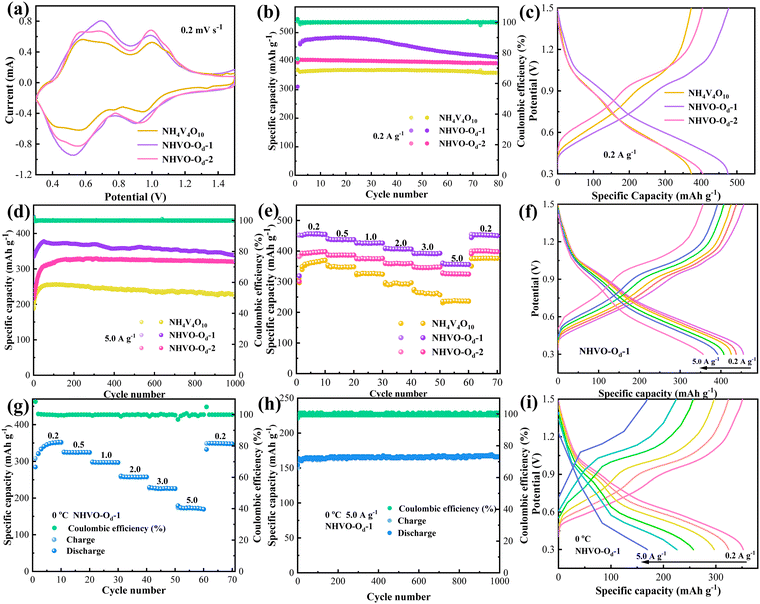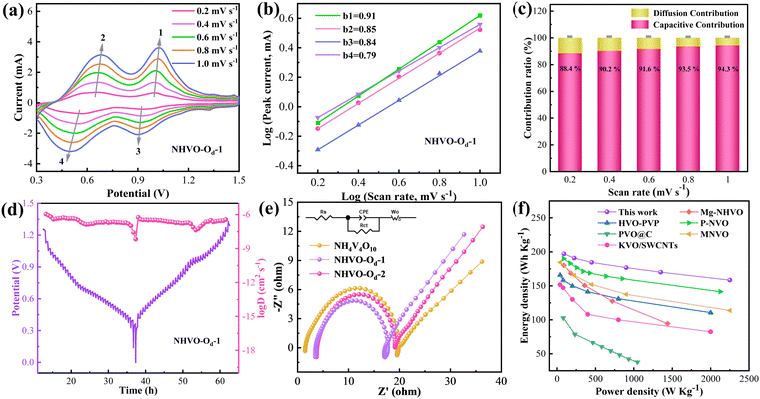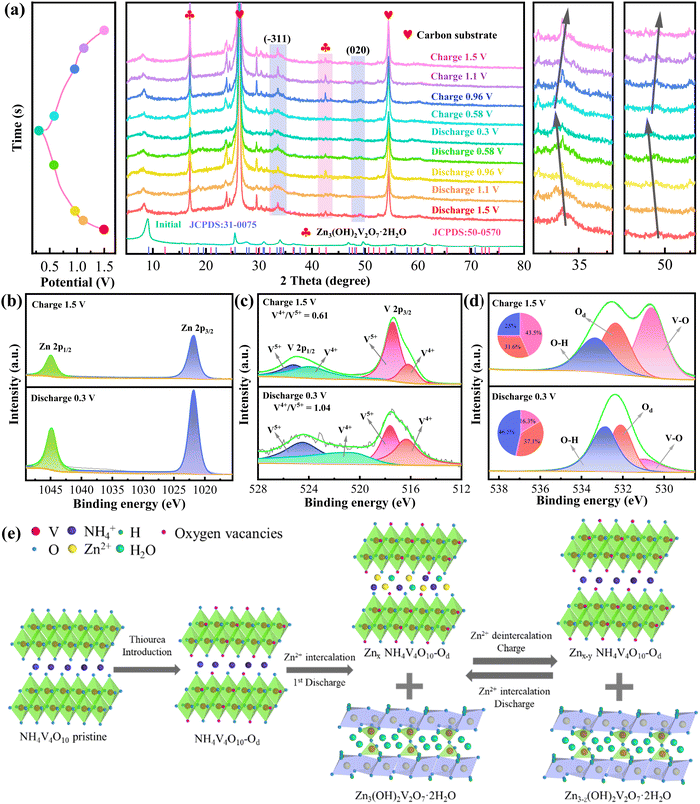Structural modulation of NH4V4O10 cathode materials for low-temperature zinc-ion energy-storage devices
Yaotong
Li†
a,
Chunru
Zhao†
a,
Wei
Wang
b,
Xiang
Wu
*a and
Yudai
Huang
*b
aSchool of Materials Science and Engineering, Shenyang University of Technology, Shenyang 110870, P. R. China. E-mail: wuxiang05@sut.edu.cn
bState Key Laboratory of Chemistry and Utilization of Carbon Based Energy Resources, College of Chemistry, Xinjiang University, Urumqi, 830017, Xinjiang, P. R. China. E-mail: hyd@xju.edu.cn
First published on 26th November 2024
Abstract
With the characteristics of nontoxicity and environmental benignity, aqueous zinc ion batteries (AZIBs) are rapidly emerging as potential competitors for high-performance energy-storage systems. Nevertheless, several issues hinder their further development, such as the sluggish electrochemical activity and inevitable dissolution of cathode materials. In this work, we introduced oxygen defects (Od) into the NH4V4O10 lattice, which facilitated the transport velocity of Zn2+ ions and enhanced their electrical conductivity. Zn//NHVO-Od-1 batteries showed a reversible capacity of 475.3 mA h g−1 at 0.2 A g−1. At low temperature (0 °C), the cells also demonstrated a capacity retention of 100% after 1000 cycles at 1.0 A g−1. Assembled soft-package devices presented favorable mechanical resilience at different bending conditions.
1. Introduction
The excessive environmental pollution and increasing greenhouse effect have stimulated the exploration of renewable energy-storage technologies.1–3 Recently, lithium-ion batteries (LIBs) have dominated the portable accessory and grid-scale energy-storage markets.4–6 However, their further application and commercialization are severely hampered by thermal runaway issues and the scarcity of lithium.7,8 AZIBs have become promising devices to replace LIBs with outstanding safety, abundant raw materials and high theoretical capacity.9,10 Therefore, it is imperative to design cathode materials that are compatible with the zinc anode. In previous reports, cathodes investigated for AZIBs include organic compounds, Prussian blue analogs (PBAs), manganese oxides and vanadium-based materials.11–14 However, manganese oxides undergo structural changes during the operating process, which can lead to rapid performance decay.15 PBAs release toxic substances and harmful gases during operation.16 Organic compounds present the intrinsic drawback of low electrical conductivity.17 Owing to the various crystal structures of vanadium (V5+ ↔ V4+ ↔ V3+) and superior safety of neutral or weakly acidic electrolytes, vanadium-based materials have attracted interest as potential cathode materials for AZIBs.18 Additionally, the introduction of defects can effectively accelerate ion-diffusion kinetics and increase the discharge capacity of the cells. Therefore, it is a widely used strategy for the modification of cathode materials.19Ammonium vanadate (NH4V4O10) materials possess an excellent Zn2+-storage ability owing to the bilayer structure of V4O10.20,21 Besides, NH4+ ions act as “pillars” to maintain the interlayer structure against the volumetric change that occurs during charging and discharging.22,23 Zong et al. synthesized deficient NH4V4O10 nanosheets via a heat-treatment route.24 Assembled batteries showed a reversible capacity of 457.0 mA h g−1 at 0.1 A g−1. Moreover, Wang and coworkers introduced Al3+ into ammonium vanadate materials using a hydrothermal approach.25 The assembled device showed a cycling capacity of 475.8 mA h g−1 at 0.2 A g−1. Liu et al. increased the interlayer spacing of NH4V4O10 by compositing it with rGO.26 The resulting cathodes presented a capacity of 551.0 mA h g−1 at 0.1 A g−1. Oxygen defects (Od) are vacancy defects formed by the loss of oxygen ions from the crystal lattice. Their appearance leads excess electrons to form defect sites, which create delocalized electron clouds to improve electronic conductivity.27 However, there has been a lack of exploration of oxygen-deficient vanadate as a cathode material for operating under severe working conditions.
In this work, we introduce oxygen defects into the lattice of NH4V4O10 nanobelts by adding thiourea. The obtained products were denoted as NHVO-Od. Thiourea was added as it can tailor the microscopic morphology and internal structural defects of materials, which can ultimately improve the reaction kinetics. An assembled Zn//NHVO-Od-1 battery showed an initial specific capacity of 475.3 mA h g−1 at 0.2 A g−1. Meanwhile, it could retain 90.8% of its initial capacity at 5.0 A g−1 for 1000 times cycling. At low temperature (0 °C), the assembled button cells achieved a cycling life of 1000 times with a capacity retention of 93.9% at 5.0 A g−1. Furthermore, soft-package devices were assembled to investigate their mechanical stability, demonstrating a capacity retention of 66.7% at 1.0 A g−1 after 600 times charging and discharging. The synergetic utilization of the PAM hydrogel and NHVO-Od-1 materials endow the flexible batteries with favorable mechanical toughness and cycling stability at 0 °C.
2. Experimental section
2.1 Material synthesis
First, 4 mmol NH4VO3 and 4 mmol H2C2O4·2H2O were dissolved in 40 mL DI and magnetically stirred for 30 min at 70 °C. Then, 1 or 2 mmol thiourea was added into the above mixture, respectively. After cooling, 4 drops of 3 M hydrochloric acid was added to adjust the pH value of the mixtures to 2. Subsequently, each mixture was transferred into 100 mL PTFE-lined autoclave and kept at 180 °C for 24 h. After cooling, the precursors were sequentially centrifuged three times alternately with anhydrous ethanol and DI. Finally, the resulting products were dried in a vacuum oven for 9 h at 60 °C. The collected samples were named as NHVO-Od-1 and NHVO-Od-2, respectively. For comparison, pure NH4V4O10 samples were also synthesized without adding thiourea.To prepare the hydrogel electrolyte (PAM), 5 g of acrylamide (AM) was dissolved into 15 mL of 3 M Zn(CF3SO3)2 electrolyte. After that, 20 mg of (NH4)2S2O8 and 3 mg of N,N-methylenebisacrylamide were subsequently added into the above mixture. After stirring, the solution was poured into a medical syringe and injected into a fixed plastic mold. The molds were dried in a drying oven at 60 °C for 3 h to obtain the PAM hydrogel.
2.2 Structure and morphology characterization
The crystal structures of the samples were characterized by X-ray diffraction (XRD, Rigaku Ultima IV, Cu Kα radiation, λ = 0.1541 nm, 40 KV). Moreover, we employed X-ray photoelectron spectroscopy (XPS, Thermo Scientific K-α) to evaluate the elemental composition of the samples. The Od was tested through electron paramagnetic resonance spectroscopy (EPR, Bruker EMXplus-6/1). Finally, the microstructure of the samples was observed by scanning electron microscopy (SEM, Gemini, 300-71-31).2.3 Electrochemical characterization
Cathode materials were prepared by evenly combining polyvinylidene fluoride (PVDF), carbon black (Super P), and the as-fabricated samples with a mass ratio of 1![[thin space (1/6-em)]](https://www.rsc.org/images/entities/char_2009.gif) :
:![[thin space (1/6-em)]](https://www.rsc.org/images/entities/char_2009.gif) 2
2![[thin space (1/6-em)]](https://www.rsc.org/images/entities/char_2009.gif) :
:![[thin space (1/6-em)]](https://www.rsc.org/images/entities/char_2009.gif) 7. Then an appropriate amount of N-methyl-l-2-pyrrolidone (NMP) was added to form a slurry, which was coated on carbon paper. The active materials showed an average loading mass of 1.4 mg g−1. Then, the samples were placed in a vacuum drying oven at 60 °C overnight. A series of coin cells were assembled with the prepared materials, zinc foils, 3 M Zn(CF3SO3)2 electrolyte, and glass fiber separators.
7. Then an appropriate amount of N-methyl-l-2-pyrrolidone (NMP) was added to form a slurry, which was coated on carbon paper. The active materials showed an average loading mass of 1.4 mg g−1. Then, the samples were placed in a vacuum drying oven at 60 °C overnight. A series of coin cells were assembled with the prepared materials, zinc foils, 3 M Zn(CF3SO3)2 electrolyte, and glass fiber separators.
For flexible devices, the cathode and anode were separated by polyacrylamide (PAM) gel electrolyte. They were encapsulated with a layer of aluminum–plastic film. A temperature test chamber (Neware, MGDW-225-40C) was employed to study the cycling performance of the devices at 0 °C. An automatic battery test system (Neware, CT-4008T) was utilized to evaluate the galvanostatic charge/discharge (GCD) curves. Electrochemical impedance spectra (EIS) and cyclic voltammetry (CV) curves were determined using an electrochemical workstation (Shanghai Chenhua, CHI660E) within the potential range of 0.3–1.5 V.
3. Results and discussion
XRD was employed to study the crystal structure of the samples. As shown in Fig. 1a, the diffraction peaks of the products matched with the NH4V4O10 phase (JCPDS no. 31-0075). The main characteristic peaks located at 9.2°, 25.5°, 27.68°, 33.93°, 47.05°, and 49.79° corresponded to the (001), (110), (111), (−311), (−205), and (020) crystal planes, respectively. Besides, the (001) peaks of the NHVO-Od-1 and NHVO-Od-2 samples were slightly shifted to the left due to the increase in Od after adding thiourea.28 During hydrothermal reactions, thiourea decomposes to form hydrogen sulfide (H2S), carbon dioxide (CO2), and ammonia (NH3). H2S gas reduces some vanadium elements of NH4V4O10 to introduce oxygen defects in products.29 Moreover, the broad peaks and rough baselines of the NHVO-Od-2 pattern demonstrated the inferior crystallinity of the products, which caused a degradation of the reversible capacity.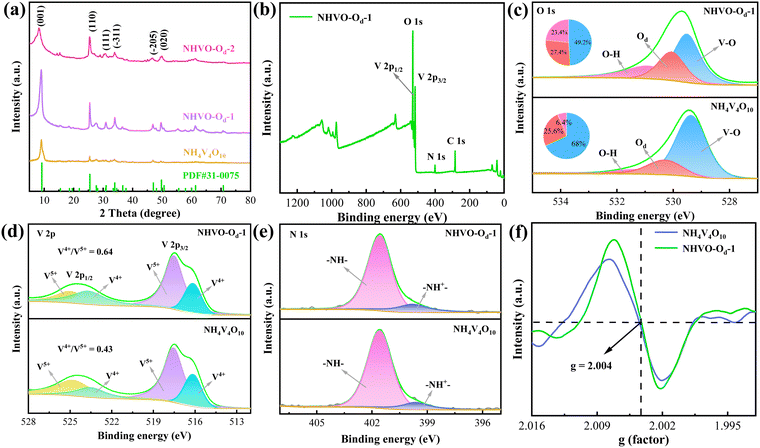 | ||
| Fig. 1 Structural characterization: (a) XRD patterns; (b) XPS survey spectra, (c) O 1s, (d) V 2p, and (e) N 1s; and (f) EPR spectra of the NH4V4O10 and NHVO-Od-1 samples. | ||
Next, we employed XPS to study the elemental valence distribution and chemical composition of the materials. Fig. 1b shows the full spectrum of the NHVO-Od-1 sample, which indicated the presence of O, V, N, and C elements. Besides, no signal peak of S was found in the spectrum. The O 1s spectra of both materials are presented in Fig. 1c. The primary peaks were de-convoluted into several peaks located at 531.48, 530.58, and 529.98 eV, which belonged to chemisorbed oxygen (O–H), oxygen defects (Od), and lattice oxygen (V–O), respectively.30 With the adding of thiourea, the ratio of oxygen defects increased from 25.6% to 27.4%, as shown in the inset. Furthermore, the presence of defects could be confirmed in V 2p spectra (Fig. 1d); whereby the signal peaks located at 517.58/524.88 and 516.18/523.58 eV corresponded to V4+ and V5+, respectively.31 By integrating the areas of the signal peaks, the calculated V4+/V5+ ratio of NHVO-Od-1 (0.64) was found to be higher than that of NH4V4O10 (0.43). This suggests that some V5+ ions were reduced to V4+, which was attributed to the many oxygen defects formed.32 The N 1s peaks were fitted to two peaks, including neutral nitrogen (–NH–) at 401.58 eV and positively charged nitrogen (–NH+–) at 399.78 eV, as shown in Fig. 1e.33 Moreover, EPR was employed to probe the concentration of oxygen defects in the products. Fig. 1f presents the spectra of the two samples with sharp and strong symmetric peaks at g = 2.004, demonstrating the consistence of oxygen defects.34 The higher signal intensity of the NHVO-Od-1 samples suggested more defects were formed, which coincided with the results in the O 1s and V 2p spectra.
Subsequently, we observed the morphology of the materials. From the SEM images, it could be seen that the NH4V4O10 samples possessed large agglomerates consisting of many nanoparticles (Fig. 2a and b). However, the NHVO-Od-1 samples presented nanobelt-like shapes, which could be explained by the spontaneous nucleation and aggregation of nanorods (Fig. 2c). The average thickness of the nanobelts was 80 nm, as described in Fig. 2d. When the addition of thiourea reached 2 mmol, the nanobelts broke and manifested a rod-shaped morphology with different lengths (Fig. 2e and f). Thus, the morphology of the materials was regulated by the amount of added thiourea.
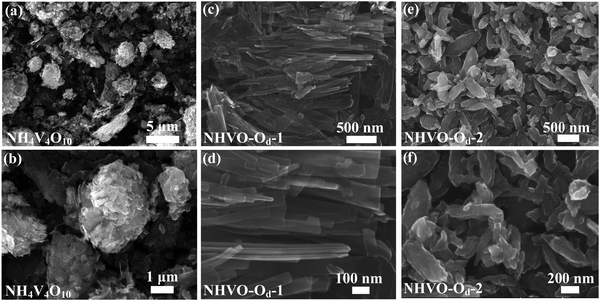 | ||
| Fig. 2 Morphology characterization: (a) and (b) SEM images of the NH4V4O10, (c) and (d) NHVO-Od-1, and (e) and (f) NHVO-Od-2 samples. | ||
To determine the electrochemical performance of the samples, detailed characterizations were performed in the potential range of 0.3–1.5 V. Fig. 3a displays the CV curves of all the devices obtained at a scan rate of 0.2 mV s−1. Thereinto, the Zn//NHVO-Od-1 battery manifested a large integrated area, revealing its high discharging capacity. Two pairs of reduction/oxidation peaks were located at 0.57/0.93 V and 0.66/1.01 V, respectively, which were in accordance with the insertion and de-insertion process of Zn2+.35Fig. 3b shows the specific capacities of all the samples at 0.2 A g−1. The reversible capacities of the NH4V4O10, NHVO-Od-1, and NHVO-Od-2 cathodes were 368.1, 475.3, and 404.6 mA h g−1 at 0.2 A g−1, respectively. After 80 times cycling, the Zn//NHVO-Od-1 devices retained a capacity of 414.7 mA h g−1 with a retention rate of 87.3%. From Fig. 3c, it could be seen that several inclined platforms appeared in the GCD curves, which were consistent with the corresponding CV curves. This demonstrates that the de-intercalation and intercalation of Zn2+ in the reaction were accompanied by the valence transition of V.36
The charge/discharge multiplier performance is a significant parameter to study the comprehensive performance of batteries. As indicated in Fig. 3d, the devices delivered capacities of 255.1, 365.4, and 329.3 mA h g−1 at a current density of 5.0 A g−1, respectively. After 1000 times cycling, the reversible capacities of the NHVO-Od-1 cathodes was still higher than those of the electrodes and they maintained a retention rate of 90.8%. The incorporation of oxygen defects accelerated the migration rate of Zn2+, which effectively improved the specific capacity and cycling stability. From Fig. 3e, it could be seen that the Zn//NHVO-Od-1 batteries possessed specific capacities of 455.9, 438.1, 426.9, 406.6, 392.6, and 360.7 mA h g−1 at 0.2, 0.5, 1.0, 2.0, 3.0, and 5.0 A g−1, respectively. This reveals that the batteries possessed excellent performance under variable operating conditions. When the current density recovered to 0.2 A g−1, they could still keep a capacity of 452.4 mA h g−1. Compared with the other two cells, the NHVO-Od-1 electrodes delivered superior rate performances. This suggests that the oxygen defects in the composite cathodes accelerate the migration rate of Zn2+ and enhance the electrical conductivity. The induction of oxygen defects produces more active sites than in the original material, which then allows accommodating extra reversible Zn2+ intercalation. However, structural collapse owing to excessive oxygen defects adversely affects the capacity of the Zn//NHVO-Od-2 devices. As shown in Fig. 3f, the reversible capacity gradually reduced as the current density increased. We further studied the discharge capacities of the Zn//NHVO-Od-1 batteries at low temperature (0 °C). The devices delivered specific capacities of 352.2, 324.6, 296.8, 257.3, 225.9, and 170.9 mA h g−1 at 0.2 to 5.0 A g−1, respectively (Fig. 3g). The presence of oxygen defects reduced the diffusion barrier and optimized the migration path of Zn2+, which accelerated the charge-transfer kinetics. When it recovered to 0.2 A g−1, the cathodes delivered a capacity of 348.6 mA h g−1. Moreover, the cells demonstrated nearly 100% capacity retention at 5.0 A g−1 after 1000 times cycling (Fig. 3h). The excellent cycling stability was attributed to the stable crystal structure of the cathode material during charging and discharging. Oxygen defects alleviates the electrostatic intercalation of Zn–O bonds, which stabilizes the lattice interlayer structure.37Fig. 3i shows the corresponding GCD curves at various current densities at low temperature. As the current density increased, the curves displayed a gradual decline in specific capacity. The consistent shape of these curves underscores their excellent cycling stability under 0 °C.
Next, we evaluated the electrode reaction kinetics behavior of the devices. Fig. 4a displays the CV curves of the devices at scan rates ranging from 0.2 to 1.0 mV s−1. As the sweep speed intensified, the negative and positive signal peaks were shift toward the low and high potential regions, respectively. A gradual expansion of the integration area is correlated with the polarization behavior during the operation of the battery. The relationship between the peak currents and scanning rates of CV curves can be fitted based on eqn (1) below:38
| i = avb | (1) |
![[thin space (1/6-em)]](https://www.rsc.org/images/entities/char_2009.gif) i vs. log
i vs. log![[thin space (1/6-em)]](https://www.rsc.org/images/entities/char_2009.gif) v), the b values were found to be 0.91, 0.85, 0.84, and 0.79, revealing the coexistence of a battery behavior and pseudocapacitive behavior in the reaction process (Fig. 4b). Eqn (1) can be further written as follows:39
v), the b values were found to be 0.91, 0.85, 0.84, and 0.79, revealing the coexistence of a battery behavior and pseudocapacitive behavior in the reaction process (Fig. 4b). Eqn (1) can be further written as follows:39| i(V) = k1v1/2+ k2v | (2) |
 | (3) |
Next, EIS was employed to study the resistance of the devices. The electrode reaction system corresponds to the current reaction signal at the interference of sinusoidal alternating current. From Fig. 4e, the X-axis represents the actual impedance value and the Y-axis represents the theoretical value, which were used to describe the electrochemical impedance spectrum caused by a series of sinusoidal alternating currents. The curves of the prepared sample consisted of a semicircle in the high-frequency region and a straight line in the low one. The high-frequency region in this figure is in the lower left, showing a semicircular curve that represents the charge-transfer resistance (Rct). By fitting the curves, it could be seen that the NHVO-Od-1 electrode delivered a lower resistance (Rct = 48.5 Ω) compared to the NH4V4O10 (Rct = 85.4 Ω) and NHVO-Od-2 (Rct = 59.3 Ω) samples. This also confirmed that oxygen defects can enhance the electron transfer in redox reactions. The power density and energy density of the batteries can be computed by the following equations:41
| P = IU/2m | (4) |
| E = QU/2m | (5) |
To explore the variation in the valence and chemical composition of the elements of the NHVO-Od-1 cathode, we subsequently studied the cathode reaction behavior through ex situ XRD (Fig. 5a). In the discharging process, the characteristic peaks gradually shifted to a low angle, indicating an expansion of the interstitial crystalline spacing. This fluctuation could be derived from the intercalation of H2O molecules and Zn2+. After charging to 1.5 V, the reflection gradually shifted to its initial position, which suggests the reversibility of the electrode structural changes. New peaks appeared at 16.98° and 42.56° during the operating states, which revealed the formation of the Zn3(OH)2V2O7·2H2O phase (JCPDS no. 50-0570). The detailed electrode can be summarized by the following formulas:48
| V5+ + 4H2O → VO2(OH)2− + 6H+ | (6) |
| 2VO2(OH)2− + 3Zn2+ + 3H2O → Zn3(OH)2V2O7·2H2O + 4H+ | (7) |
Subsequently, ex situ XPS was employed to characterize the elemental valence changes of the electrodes. As shown in Fig. 5b, two distinct signal peaks could be observed at 1021.78 and 1044.98 eV, which corresponded to Zn 2p3/2 and Zn 2p1/2, respectively. The peak intensity of Zn 2p increased significantly as the discharge continued, which indicated that Zn2+ was successfully embedded in the lattice. Fig. 5c presents the XPS spectra of V 2p, with peaks assigned to V5+ (525.28/517.78 eV) and V4+ (524.18/516.58 eV), respectively. By integrating the area of the signal peaks, we obtained the ratios of the V4+ and V5+ contents. In the charging state, the ratio decreased from 1.04 to 0.61, which revealed the embedding of Zn2+ and occurrence of the redox reaction. Moreover, Fig. 5d demonstrates the XPS spectra of O 1s. As the pie charts show in the inset, the percentage oxygen content was obtained by integrating the area of each signal peak. When discharged to 0.3 V, there was a significant increase in the ratio of H2O molecular (O–H). When charged to 1.5 V, the peak intensity of absorbed oxygen weakened, which indicated the involvement of both Zn2+ and H2O.49
The schematic in Fig. 5e depicts the conversion process of the batteries. To further understand the Zn2+-storage mechanism, the detailed cathode reaction processes involved are summarized as follows:
The 1st discharge process:
| NH4V4O10-Od + xZn2+ + 2xe− → ZnxNH4V4O10-Od + Zn3(OH)2V2O7·2H2O | (8) |
| ZnxNH4V4O10-Od + Zn3(OH)2V2O7·2H2O − (y + z)Zn2+ − 2(y + z)e− ↔ Znx−yNH4V4O10-Od + Zn3−z(OH)2V2O7·2H2O | (9) |
To further demonstrate the potential application of the prepared materials, we prepared flexible devices using NHVO-Od-1 samples as the cathode. As presented in Fig. 6a, the cathode and anode were separated by PAM and subsequently sealed with an aluminum–plastic film. The mechanical property of the batteries was then investigated in different conditions. Fig. 6b shows the GCD curves at 1.0 A g−1 under different bending angles. It could be observed that the curves maintained two platforms, which was basically similar to what was seen with button cell batteries. In the flat state, the discharged time of the battery reached about 1300 s. In the completely bent state, the discharge time significantly decreased. This could be attributed to the tight contact between the electrodes and the PAM becoming tighter under external folding pressure. When the device was restored to the freestanding state, the capacity manifested a reduction due to the loss of external pressure, which reduced the contact area. Fig. 6c displays the EIS spectra obtained for different bending degrees from 0° to 360°. The Rct values gradually increased as the bending degree changed. When it returned to the initial folding condition, the corresponding value was close to that of the flat state, which indicates the high mechanical recoverability. At ambient temperature, the flexible devices delivered an initial capacity of 253.9 mA h g−1 at 1.0 A g−1. As shown in Fig. 6d, they maintained a retention ratio of 66.7% after 600 times cycling. Moreover, the batteries achieved a retention rate of 93.9% at 0 °C.
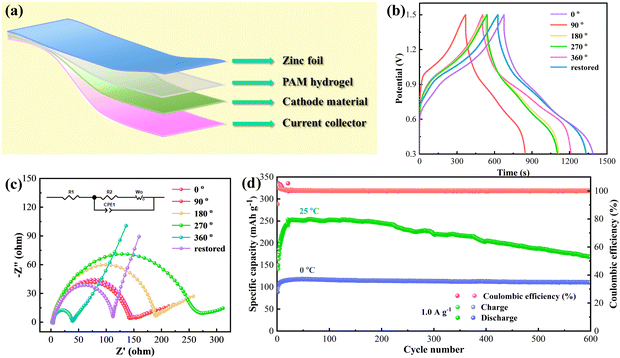 | ||
| Fig. 6 (a) Flexible device structure schematic. (b) GCD curves in the 1.0 A g−1. (c) EIS spectra. (d) Long-term cycles at 25 °C and 0 °C. | ||
4. Conclusions
In summary, we synthetized oxygen defects (Od)-containing NH4V4O10 (NHVO-Od) nanobelts through a hydrothermal route. During the synthesis procedure, the introduction of thiourea formed abundant Od sites in the samples. The presence of Od significantly promoted the electrical conductivity and improved the diffusion of Zn2+ and H2O molecules. Benefiting from these merits, the assembled Zn//NHVO-Od-1 coin batteries delivered an outstanding specific capacity and long cycle life. The soft pack device also showed favorable cycling stability under bending states. Moreover, the cathodes manifested excellent electrochemical performance at low temperature. It is hoped that this exploration in vanadate materials will prompt the further design of high-rate and long-cyclability energy-storage systems to operate under extreme operating conditions.Author contributions
Yaotong Li, Chunru Zhao and Wei Wang: conceptualization, software, data curation and writing – original draft preparation, Xiang Wu and Yudai Huang: supervision, writing – reviewing and editing.Data availability
The data and materials used to support the findings of this study are available from the corresponding author upon request.Conflicts of interest
The authors declare no conflict of interestAcknowledgements
This project is supported by National Natural Science Foundation of China (No. 52172218).References
- J. Xiao, X. Li, K. Tang, D. Wang, M. Long, H. Gao, W. Chen, C. Liu, H. Liu and G. Wang, Recent progress of emerging cathode materials for sodium ion batteries, Mater. Chem. Front., 2021, 5, 3735–3764 RSC
.
- J. Zhang and X. Wu, Dual ion carrier storage through the addition of Mg2+ for high-energy and long-life zinc-ion hybrid capacitor, Int. J. Miner., Metall. Mater., 2024, 31, 179–185 CrossRef CAS
.
- J. Lin, X. Zhang, E. Fan, R. Chen, F. Wu and L. Li, Carbon neutrality strategies for sustainable batteries: from structure, recycling, and properties to applications, Energy Environ. Sci., 2023, 16, 745–791 RSC
.
- Y. Yang, E. G. Okonkwo, G. Huang, S. Xu, W. Sun and Y. He, On the sustainability of lithium ion battery industry-a review and perspective, Energy Storage Mater., 2021, 36, 186–212 CrossRef
.
- B. Tong and X. Li, Towards separator safety of lithium-ion batteries: a review, Mater. Chem. Front., 2024, 8, 309–340 RSC
.
- Y. Shao, J. Xu, A. Amardeep, Y. Xia, X. Meng, J. Liu and S. Liao, Lithium-ion conductive coatings for nickel-rich cathodes for lithium-ion batteries, Small Methods, 2024, 2400256 CrossRef
.
- H. Ji, J. Wang, J. Ma, H. Cheng and G. Zhou, Fundamentals, status and challenges of direct recycling technologies for lithium ion batteries, Chem. Soc. Rev., 2023, 52, 8194–8244 RSC
.
- P. Li, Y. Wang, Z. Liu and X. Hu, Acid-scavenging separators promise long-term cycling stability of lithium-ion batteries, Mater. Chem. Front., 2023, 7, 6318–6344 RSC
.
- I. R. Tay, J. Xue and W. S. Lee, Methods for characterizing intercalation in aqueous zinc ion battery cathodes: a review, Adv. Sci., 2023, 10, 2303211 CrossRef CAS
.
- J. Cao, F. Zhao, W. Guan, X. Yang, Q. Zhao, L. Gao, X. Ren, G. Wu and A. Liu, Additives for aqueous zinc-ion batteries: recent progress, mechanism analysis, and future perspectives, Small, 2024, 20, 2400221 CrossRef CAS
.
- M. Chen, S. Zhang, Z. Zou, S. Zhong, W. Ling, J. Geng, F. Liang, X. Peng, Y. Gao and F. Yu, Review of vanadium-based oxide cathodes as aqueous zinc-ion batteries, Rare Met., 2023, 42, 2868–2905 CrossRef CAS
.
- M. Li, C. Liu, J. Meng, P. Hei, Y. Sai, W. Li, J. Wang, W. Cui, Y. Song and X. X. Liu, Hydroxylated manganese oxide cathode for stable aqueous zinc-ion batteries, Adv. Funct. Mater., 2024, 34, 2405659 CrossRef CAS
.
- Y. Li, J. Zhao, Q. Hu, T. Hao, H. Cao, X. Huang, Y. Liu, Y. Zhang, D. Lin, Y. Tang and Y. Cai, Prussian blue analogs cathodes for aqueous zinc ion batteries, Mater. Today Energy., 2022, 29, 101095 CrossRef CAS
.
- Z. Tie and Z. Niu, Design strategies for high-performance aqueous Zn/organic batteries, Angew. Chem., Int. Ed., 2020, 59, 21293–21303 CrossRef CAS
.
- J. Li, N. Luo, L. Kang, F. Zhao, Y. Jiao, T. J. Macdonald, M. Wang, I. P. Parkin, P. R. Shearing, D. J. L. Brett, G. Chai and G. He, Hydrogen-bond reinforced superstructural manganese oxide as the cathode for ultra-stable aqueous zinc ion batteries, Adv. Energy Mater., 2022, 12, 2201840 CrossRef CAS
.
- Z. Li, M. Dadsetan, J. Gao, S. Zhang, L. Cai, A. Naseri, M. E. Jimenez-Castaneda, T. Filley, J. T. Miller, M. J. Thomson and V. G. Pol, Revealing the thermal safety of prussian blue cathode for safer nonaqueous batteries, Adv. Energy Mater., 2021, 11, 2101764 CrossRef CAS
.
- Y. An, H. Zhang, D. Geng, Z. Fu, Z. Liu, J. He, Y. Zhao, M. Shi and C. Yan, Double redox-active polyimide-based covalent organic framework induced by lithium ion for boosting high-performance aqueous Zn2+ storage, Chem. Eng. J., 2023, 477, 147275 CrossRef CAS
.
- Y. Liu, Y. Liu and X. Wu, Pre-intercalation strategies to layered vanadium-based electrode materials for aqueous zinc batteries, Batteries Supercaps, 2023, 6, e202200461 CrossRef CAS
.
- T. Xiong, Y. Zhang, W. S. V. Lee and J. Xue, Defect engineering in manganese-based oxides for aqueous rechargeable zinc-ion batteries: a review, Adv. Energy Mater., 2020, 10, 2001769 CrossRef CAS
.
- R. Liu, J. Liu, Y. Li, C. Zhang and H. Li, Aqueous aluminum-ion batteries based on layered NH4V4O10 nanosheets as cathode, Solid State Sci., 2023, 145, 107315 CrossRef CAS
.
- Y. Zhuang, Q. Zong, Y. Wu, C. Liu, Q. Zhang, D. Tao, J. Zhang, J. Wang and G. Cao, Tuning [VO6] octahedron of ammonium vanadates via F incorporation for high-performance aqueous zinc ion batteries, Small, 2024, 20, 2306561 CrossRef CAS PubMed
.
- B. Tang, J. Zhou, G. Fang, F. Liu, C. Zhu, C. Wang, A. Pan and S. Liang, Engineering the interplanar spacing of ammonium vanadates as a high performance aqueous zinc-ion battery cathode, J. Mater. Chem. A, 2019, 7, 940–945 RSC
.
- S. Li, D. Yu, J. Liu, N. Chen, Z. Shen, G. Chen, S. Yao and F. Du, Quantitative regulation of interlayer space of NH4V4O10 for fast and durable Zn2+ and NH4+ Storage, Adv. Sci., 2023, 10, 2206836 CrossRef CAS
.
- Q. Zong, W. Du, C. Liu, H. Yang, Q. Zhang, Z. Zhou, M. Atif, M. Alsalhi and G. Cao, Enhanced reversible zinc ion intercalation in deficient ammonium vanadate for high-performance aqueous zinc-ion battery, Nano-Micro Lett., 2021, 13, 116 CrossRef CAS
.
- K. Wang, R. Yuan, M. Li, Y. Huang, W. Ai, Z. Du, P. He and B. Wang, Al3+ intercalated NH4V4O10 nanosheet on carbon cloth for high-performance aqueous zinc-ion batteries, Chem. Eng. J., 2023, 471, 144655 CrossRef CAS
.
- L. Liu, K. Chen, Z. Li and W. Huang, NH4V4O10/rGO heterostructure with enlarged (001) plane spacing for aqueous zinc-ion batteries with high zinc storage and highly reversible Zn2+ insertion/extraction, ACS Appl. Energy Mater., 2023, 6, 8634–8643 CrossRef CAS
.
- Y. Liu, Y. Liu and X. Wu, Defect engineering of vanadium-based electrode materials for zinc ion battery, Chin. Chem. Lett., 2023, 34, 107839 CrossRef CAS
.
- J. Cao, D. Zhang, Y. Yue, X. Wang, T. Pakornchote, T. Bovornratanaraks, X. Zhang, Z. S. Wu and J. Qin, Oxygen defect enriched (NH4)2V10O25·8H2O nanosheets for superior aqueous zinc-ion batteries, Nano Energy, 2021, 84, 105876 CrossRef CAS
.
- X. Chang, X. F. Yang, Y. Qiao, S. Wang, M. H. Zhang, J. Xu, D. H. Wang and X. H. Bu, Confined heteropoly blues in defected Zr-MOF (bottle around ship) for high-efficiency oxidative
desulfurization, Small, 2020, 16, 1906432 CrossRef CAS
.
- J. Chen, Y. Zhai, Y. Li, X. Zhang, X. Zhang, Y. Chen, Y. Zeng, X. Wu, Q. Zheng, K. Lam, X. Tan and D. Lin, Optimizing interplanar spacing, oxygen vacancies and micromorphology via lithium-ion pre-insertion into ammonium vanadate nanosheets for advanced cathodes in aqueous zinc-ion batteries, Small, 2024, 20, 2309412 CrossRef CAS
.
- M. Zhao, S. Li, X. Wu and S. Luo, Gallium ion pre-insertion protocol to (NH4)2V10O25·8H2O cathode materials for reversible aqueous Zn battery, Adv. Mater. Technol., 2024, 9, 2400125 CrossRef CAS
.
- Q. Zang, X. Cheng, S. Chen, Z. Xiao, K. Wang, L. Zong, Q. Zhang and L. Wang, Oxygen defect engineering triggered by S-doping boosts the performance of H2V3O8 nanobelts for aqueous Zn-ion storage, Chem. Eng. J., 2023, 452, 139396 CrossRef CAS
.
- T. Wei, Y. Liu, G. Yang and C. Wang, Aluminum vanadate hollow spheres as zero-strain cathode material for highly reversible and durable aqueous zinc-ion batteries, Energy Storage Mater., 2020, 30, 130–137 CrossRef
.
- Y. Liu and X. Wu, High durable aqueous zinc ion batteries by synergistic effect of V6O13/VO2 electrode materials, J. Energy Chem., 2023, 87, 334–341 CrossRef CAS
.
- Y. Liu and X. Wu, Metal-organic framework assisted design of ZnVOx cathode for aqueous zinc batteries at extreme work condition, Nano Energy, 2024, 127, 109809 CrossRef CAS
.
- Y. Du, X. Wang and J. Sun, Tunable oxygen vacancy concentration in vanadium oxide as mass-produced cathode for aqueous zinc-ion batteries, Nano Res., 2021, 14, 754–761 CrossRef CAS
.
- Q. Zong, Q. Q. Wang, C. Liu, D. Tao, J. Wang, J. Zhang, H. Du, J. Chen, Q. Zhang and G. Cao, Potassium ammonium vanadate with rich oxygen vacancies for fast and highly stable Zn-ion storage, ACS Nano, 2022, 16, 4588–4598 CrossRef CAS
.
- Y. Liu, Y. Liu, X. Wu and Y. Cho, General carbon modification avenue to construct highly stable V2O5 electrodes for aqueous zinc-ion batteries, ACS Sustainable Chem. Eng., 2023, 11, 13298–13305 CrossRef CAS
.
- L. Chen, Y. Zheng, Z. Zhang, Y. Ma, Y. Wang, H. Xiao, M. Xu, Z. Li and G. Yuan, Optimizing ammonium vanadate crystal structure by facile in situ phase transformation of VO2/NH4V4O10 with special micro-nano feature for advanced aqueous zinc ion batteries, Inorg. Chem. Front., 2024, 11, 1266–1278 RSC
.
- J. Chen, L. Su, X. Zhang, Y. Chen, P. Wang, Q. Zheng and D. Lin, Ethylene glycol intercalation engineered interplanar spacing and redox activity of ammonium vanadate nanoflowers as a high-performance cathode for aqueous zinc-ion batteries, ACS Sustainable Chem. Eng., 2023, 11, 12467–12476 CrossRef CAS
.
- M. Zhao, S. Li, X. Wu and L. Sun, Regulating oxygen vacancies in ammonium vanadate electrode materials for advanced aqueous zinc ion batteries, iScience, 2024, 27, 110926 CrossRef CAS
.
- X. Wang, Y. Wang, A. Naveed, G. Li, H. Zhang, Y. Zhou, A. Dou, M. Su, Y. Liu, R. Guo and C. Li, Magnesium ion doping and micro-structural engineering assist NH4V4O10 as a high-performance aqueous zinc ion battery cathode, Adv. Funct. Mater., 2023, 33, 2306205 CrossRef CAS
.
- F. Wan, S. Huang, H. Cao and Z. Niu, Freestanding potassium vanadate/carbon nanotube films for ultralong-life aqueous zinc-ion batteries, ACS Nano, 2020, 14, 6752–6760 CrossRef CAS PubMed
.
- H. Tang, F. Chao, H. Luo, K. Yu, J. Wang, H. Chen, R. Jia, F. Xiong, Y. Pi, P. Luo and Q. An, Mg2+ ion pre-insertion boosting reaction kinetics and structural stability of ammonium vanadates for high performance aqueous zinc-ion batteries, ChemSusChem, 2023, 16, e202300403 CrossRef CAS
.
- C. Zhao, Y. Liu, S. Li, X. Wu and J. Liu, PVP decorated H3.78V6O13 microspheres assembled by nanosheets for aqueous zinc ion batteries at variable work temperature, Chin. Chem. Lett., 2025, 36, 110185 Search PubMed
.
- X. Liang, L. Yan, W. Li, Y. Bai, C. Zhu, Y. Qiang, B. Xiong, B. Xiang and X. Zou, Flexible high-energy and stable rechargeable vanadium-zinc battery based on oxygen defect modulated V2O5 cathode, Nano Energy, 2021, 87, 106164 CrossRef CAS
.
- X. Zhang, X. Sun and C. Zheng, Interlayer-modified pseudocapacitive ammonium vanadium with high reversibility and stability enabling high-performance aqueous zinc-ion battery, Chem. Eng. J., 2023, 471, 144571 CrossRef CAS
.
- C. Zhao, Y. Liu, X. Wu and S. Luo, Graphene oxide wrapped VO2 nanobelts for calendar-life Zn storage devices, Adv. Sustainable Syst., 2024, 8, 2400077 CrossRef CAS
.
- S. Li, X. Xu, W. Chen, J. Zhao, K. Wang, J. Shen, X. Chen, X. Lu, X. Jiao, Y. Liu and Y. Bai, Synergetic impact of oxygen and vanadium defects endows NH4V4O10 cathode with superior performances for aqueous zinc-ion battery, Energy Storage Mater., 2024, 65, 103108 CrossRef
.
Footnote |
| † These two authors contribute equally. |
| This journal is © the Partner Organisations 2025 |

